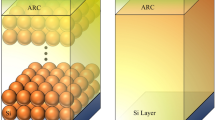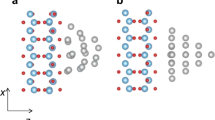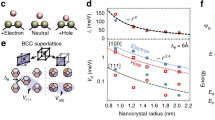Abstract
The conversion of solar radiation into electric current with high efficiency is one of the most important topics of modern scientific research, as it holds great potential as a source of clean and renewable energy. Exploitation of interaction between nanocrystals seems to be a promising route to the establishment of third-generation photovoltaics. Here, we adopt a fully ab initio scheme to estimate the role of nanoparticle interplay in the carrier multiplication dynamics of interacting silicon nanocrystals. Energy and charge transfer-based carrier multiplication events are studied as a function of nanocrystal separation, demonstrating the benefits induced by the wavefunction sharing regime. We prove the relevance of these recombinative mechanisms for photovoltaic applications in the case of silicon nanocrystals arranged in dense arrays, quantifying at an atomic scale which conditions maximize the outcome.
This is a preview of subscription content, access via your institution
Access options
Subscribe to this journal
Receive 12 print issues and online access
$209.00 per year
only $17.42 per issue
Buy this article
- Purchase on Springer Link
- Instant access to full article PDF
Prices may be subject to local taxes which are calculated during checkout






Similar content being viewed by others
References
Ellingson, R. J. et al. Highly efficient multiple exciton generation in colloidal PbSe and PbS quantum dots. Nano Lett. 5, 865–871 (2005).
Schaller, R. D. & Klimov, V. I. High efficiency carrier multiplication in PbSe nanocrystals: implications for solar energy conversion. Phys. Rev. Lett. 92, 186601 (2004).
Trinh, M. T. et al. In spite of recent doubts carrier multiplication does occur in PbSe nanocrystals. Nano Lett. 8, 1713–1718 (2008).
Nair, G., Geyer, S. M., Chang, L.-Y. & Bawendi, M. G. Carrier multiplication yields in PbS and PbSe nanocrystals measured by transient photoluminescence. Phys. Rev. B 78, 125325 (2008).
Schaller, R. D., Sykora, M., Pietryga, J. M. & Klimov, V. I. Seven excitons at a cost of one: redefining the limits for conversion efficiency of photons into charge carriers. Nano Lett. 6, 424–429 (2006).
Semonin, O. E. Peak external photocurrent quantum efficiency exceeding 100% via MEG in a quantum dot solar cell. Science 334, 1530–1533 (2011).
Schaller, R. D., Petruska, M. A. & Klimov, V. I. Effect of electronic structure on carrier multiplication efficiency: comparative study of PbSe and CdSe nanocrystals. Appl. Phys. Lett. 87, 253102 (2005).
Schaller, R. D., Sykora, M., Jeong, S. & Klimov, V. I. High-efficiency carrier multiplication and ultrafast charge separation in semiconductor nanocrystals studied via time-resolved photoluminescence. J. Phys. Chem. B 110, 25332–24338 (2006).
Gachet, D., Avidan, A., Pinkas, I. & Oron, D. An upper bound to carrier multiplication efficiency in type II colloidal quantum dots. Nano Lett. 10, 164–170 (2010).
Murphy, J. E. et al. PbTe colloidal nanocrystals: synthesis, characterization, and multiple exciton generation. J. Am. Chem. Soc. 128, 3241–3247 (2006).
Schaller, R. D., Pietryga, J. M. & Klimov, V. I. Carrier multiplication in InAs nanocrystal quantum dots with an onset defined by the energy conservation limit. Nano Lett. 7, 3469–3476 (2007).
Beard, M. C. et al. Multiple exciton generation in colloidal silicon nanocrystals. Nano Lett. 7, 2506–2512 (2007).
Pijpers, J. J. H. et al. Carrier multiplication and its reduction by photodoping in colloidal InAs quantum dots. J. Phys. Chem. C 111, 4146–4152 (2007).
Ben-Lulu, M., Mocatta, D., Bonn, M., Banin, U. & Ruhman, S. On the absence of detectable carrier multiplication in a transient absorption study of InAs/CdSe/ZnSe Core/Shell1/Shell2 quantum dots. Nano Lett. 8, 1207–1211 (2008).
McGuire, J. A., Joo, J., Pietryga, J. M., Schaller, R. D. & Klimov, V. I. New aspects of carrier multiplication in semiconductor nanocrystals. Acc. Chem. Res. 41, 1810–1819 (2008).
Ji, M. et al. Efficient multiple exciton generation observed in colloidal PbSe quantum dots with temporally and spectrally resolved intraband excitation. Nano Lett. 9, 1217–1222 (2009).
Nair, G. & Bawendi, M. G. Carrier multiplication yields of CdSe and CdSe nanocrystals by transient photoluminescence spectroscopy. Phys. Rev. B 76, 081304 (2007).
Delerue, C., Allan, G., Pijpers, J. J. H. & Bonn, M. Carrier multiplication in bulk and nanocrystalline semiconductors: mechanism, efficiency, and interest for solar cells. Phys. Rev. B 81, 125306 (2010).
McGuire, J. A., Sykora, M., Joo, J., Pietryga, J. M. & Klimov, V. I. Apparent versus true carrier multiplication yields in semiconductor nanocrystals. Nano Lett. 10, 2049–2057 (2010).
Nair, G., Chang, L. Y., Geyer, S. M. & Bawendi, M. G. Perspective on the prospects of a carrier multiplication nanocrystal solar cell. Nano Lett. 11, 2145–2151 (2011).
Timmerman, D., Izeddin, I. & Gregorkiewicz, T. Saturation of luminescence from Si nanocrystals embedded in SiO2 . Phys. Status Solidi A 207, 183–187 (2010).
Timmerman, D., Izeddin, I., Stallinga, P., Yassievich, I. N. & Gregorkiewicz, T. Space-separated quantum cutting with silicon nanocrystals for photovoltaic applications. Nature Photon. 2, 105–109 (2008).
Timmerman, D., Valenta, J., Dohnalova, K., de Boer, W. D. A. M. & Gregorkiewicz, T. Step-like enhancement of luminescence quantum yield of silicon nanocrystals. Nature Nanotech. 6, 710–713 (2011).
Trinh, M. T. et al. Direct generation of multiple excitons in adjacent silicon nanocrystals revealed by induced absorption. Nature Photon. 6, 316–321 (2012).
Califano, M., Zunger, A. & Franceschetti, A. Efficient inverse Auger recombination at threshold in CdSe nanocrystals. Nano Lett. 4, 525–531 (2004).
Allan, G. & Delerue, C. Role of impact ionization in multiple exciton generation in PbSe nanocrystals. Phys. Rev. B 73, 205423 (2006).
Franceschetti, A., An, J. M. & Zunger, A. Impact ionization can explain carrier multiplication in PbSe quantum dots. Nano Lett. 6, 2191–2195 (2006).
Allan, G. & Delerue, C. Fast relaxation of hot carriers by impact ionization in semiconductor nanocrystals: role of defects. Phys. Rev. B 79, 195324 (2009).
Rabani, E. & Baer, R. Distribution of multiexciton generation rates in CdSe and InAs nanocrystals. Nano Lett. 8, 4488–4492 (2008).
Shabaev, A., Efros, A. L. & Nozik, A. J. Multiexciton generation by a single photon in nanocrystals. Nano Lett. 6, 2856–2863 (2006).
Schaller, R. D., Agranovich, V. M. & Klimov, V. I. High-efficiency carrier multiplication through direct photogeneration of multi-excitons via virtual single-exciton states. Nature Phys. 1, 189–194 (2005).
Rabani, E. & Baer, R. Theory of multiexciton generation in semiconductor nanocrystals. Chem. Phys. Lett. 496, 227–235 (2010).
Govoni, M., Marri, I. & Ossicini, S. Auger recombination in Si and GaAs semiconductors: ab initio results. Phys. Rev. B 84, 075215 (2011).
Beard, M. C. et al. Comparing multiple exciton generation in quantum dots to impact ionization in bulk semiconductors: implications for enhancement of solar energy conversion. Nano Lett. 10, 3019–3027 (2010).
Navarro-Urrios, D. et al. Energy transfer between amorphous Si nanoclusters and Er3+ ions in a SiO2 matrix. Phys. Rev. B 79, 193312 (2009).
Pitanti, A. et al. Energy transfer mechanism and Auger effect in Er3+ coupled silicon nanoparticle samples. J. Appl. Phys. 108, 053518 (2010).
Gali, A., Voros, M., Rocca, D., Zimanyi, G. T. & Galli, G. High-energy excitations in silicon nanoparticles. Nano Lett. 9, 3780–3785 (2009).
Aerts, M. et al. Free charges produced by carrier multiplication in strongly coupled PbSe quantum dot films. Nano Lett. 11, 4485–4489 (2011).
Giannozzi, P. et al. Quantum Espresso: a modular and open-source software project for quantum simulations of materials. J. Phys. Condens. Matter 21, 395502 (2009).
Marini, A., Hogan, C., Grüning, M. & Varsano, D. Yambo: an ab initio tool for excited state calculations. Comput. Phys. Commun. 180, 1392–1403 (2009).
Humphrey, W., Dalke, A. & Schulten, K. VMD – Visual Molecular Dynamics. J. Mol. Graphics 14, 33–38 (1996).
Acknowledgements
The authors thank the Super-Computing Interuniversity Consortium CINECA for support and high-performance computing resources under the Italian Super-Computing Resource Allocation (ISCRA) initiative, and the European Community's Seventh Framework Programme (FP7/2007-2013; grant agreement 245977). The authors thank G. Cantele and F. Iori for fruitful discussions.
Author information
Authors and Affiliations
Contributions
M.G., I.M and S.O. conceived the project. M.G. and I.M. designed and performed simulations with a code developed by M.G., and co-wrote the manuscript. I.M. and S.O. supervised the project. All authors discussed the results and implications and commented on the manuscript at all stages.
Corresponding authors
Ethics declarations
Competing interests
The authors declare no competing financial interests.
Supplementary information
Supplementary information
Supplementary information (PDF 408 kb)
Supplementary Movie
Supplementary Movie (MOV 3789 kb)
Rights and permissions
About this article
Cite this article
Govoni, M., Marri, I. & Ossicini, S. Carrier multiplication between interacting nanocrystals for fostering silicon-based photovoltaics. Nature Photon 6, 672–679 (2012). https://doi.org/10.1038/nphoton.2012.206
Received:
Accepted:
Published:
Issue Date:
DOI: https://doi.org/10.1038/nphoton.2012.206
This article is cited by
-
Efficient carrier multiplication in CsPbI3 perovskite nanocrystals
Nature Communications (2018)
-
Phosphorescent Energy Downshifting for Diminishing Surface Recombination in Silicon Nanowire Solar Cells
Scientific Reports (2018)
-
Photon antibunching in a cluster of giant CdSe/CdS nanocrystals
Nature Communications (2018)
-
Thermally stimulated exciton emission in Si nanocrystals
Light: Science & Applications (2017)
-
Metal-Insulator Transition in Nanoparticle Solids: Insights from Kinetic Monte Carlo Simulations
Scientific Reports (2017)



